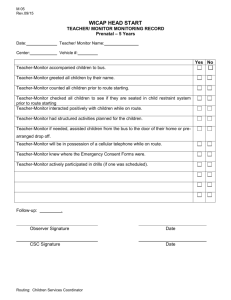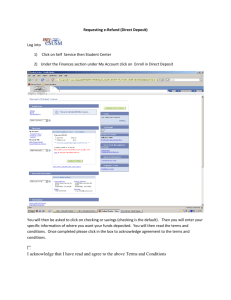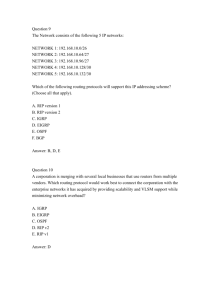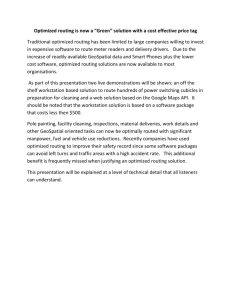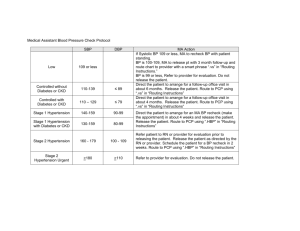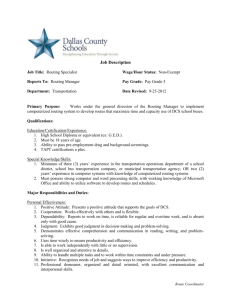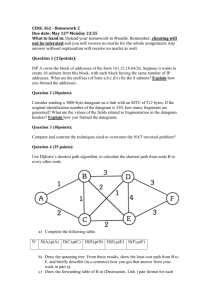The Routing Table
advertisement
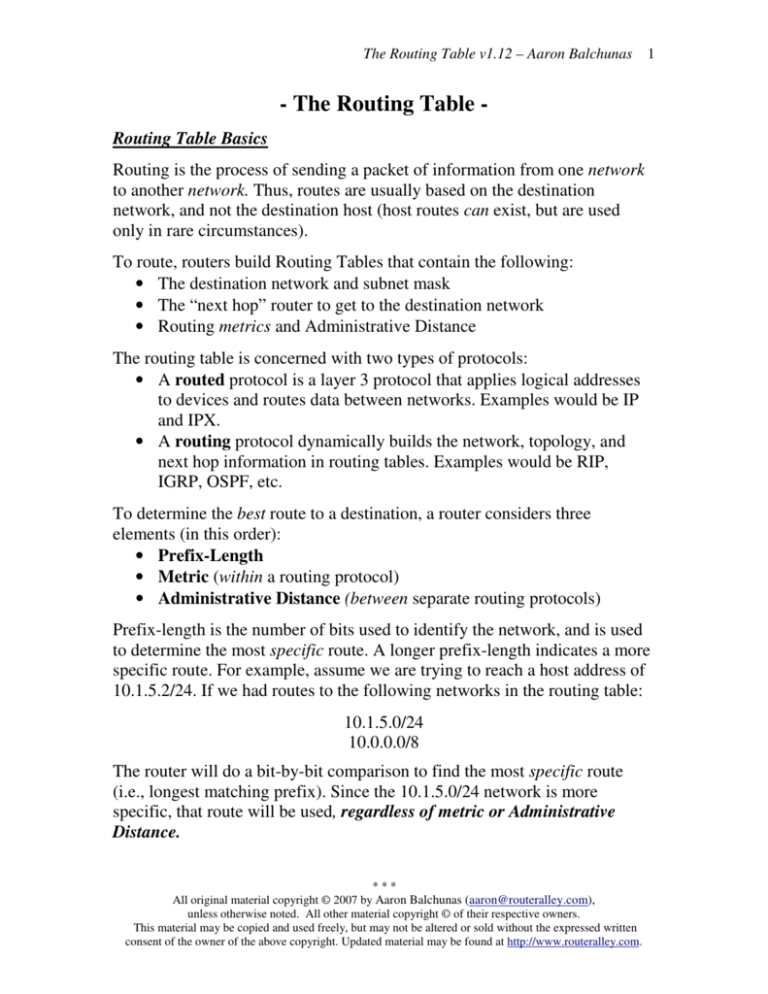
The Routing Table v1.12 – Aaron Balchunas 1 - The Routing Table Routing Table Basics Routing is the process of sending a packet of information from one network to another network. Thus, routes are usually based on the destination network, and not the destination host (host routes can exist, but are used only in rare circumstances). To route, routers build Routing Tables that contain the following: • The destination network and subnet mask • The “next hop” router to get to the destination network • Routing metrics and Administrative Distance The routing table is concerned with two types of protocols: • A routed protocol is a layer 3 protocol that applies logical addresses to devices and routes data between networks. Examples would be IP and IPX. • A routing protocol dynamically builds the network, topology, and next hop information in routing tables. Examples would be RIP, IGRP, OSPF, etc. To determine the best route to a destination, a router considers three elements (in this order): • Prefix-Length • Metric (within a routing protocol) • Administrative Distance (between separate routing protocols) Prefix-length is the number of bits used to identify the network, and is used to determine the most specific route. A longer prefix-length indicates a more specific route. For example, assume we are trying to reach a host address of 10.1.5.2/24. If we had routes to the following networks in the routing table: 10.1.5.0/24 10.0.0.0/8 The router will do a bit-by-bit comparison to find the most specific route (i.e., longest matching prefix). Since the 10.1.5.0/24 network is more specific, that route will be used, regardless of metric or Administrative Distance. *** All original material copyright © 2007 by Aaron Balchunas (aaron@routeralley.com), unless otherwise noted. All other material copyright © of their respective owners. This material may be copied and used freely, but may not be altered or sold without the expressed written consent of the owner of the above copyright. Updated material may be found at http://www.routeralley.com. The Routing Table v1.12 – Aaron Balchunas 2 Administrative Distance vs. Metric A “metric” allows a router to choose the best path within a routing protocol. Distance vector routing protocols use “distance” (usually hop-count) as their metric. Link state protocols utilize some sort of “cost” as their metric. Only routes with the best metric are added to the routing table. Thus, even if a particular routing protocol (for example, RIP) has four routes to the same network, only the route with the best metric (hop-count in this example) would make it to the routing table. If multiple equal-metric routes exist to a particular network, most routing protocols will load-balance. If your router is running multiple routing protocols, Administrative Distance is used to determine which routing protocol to trust the most. Lowest administrative distance wins. Again: if a router receives two RIP routes to the same network, it will use the routes’ metric to determine which path to use. If the metric is identical for both routes, the router will load balance between both paths. If a router receives a RIP and an OSPF route to the same network, it will use Administrative Distance to determine which routing path to choose. The Administrative Distance of common routing protocols (remember, lowest wins): Connected Static EIGRP Summary External BGP Internal EIGRP IGRP OSPF IS-IS RIP External EIGRP Internal BGP Unknown 0 1 5 20 90 100 110 115 120 170 200 255 A route with an “unknown” Administrative Distance will never be inserted into the routing table. *** All original material copyright © 2007 by Aaron Balchunas (aaron@routeralley.com), unless otherwise noted. All other material copyright © of their respective owners. This material may be copied and used freely, but may not be altered or sold without the expressed written consent of the owner of the above copyright. Updated material may be found at http://www.routeralley.com. The Routing Table v1.12 – Aaron Balchunas 3 Viewing the routing table The following command will allow you to view the routing table: Router# show ip route Gateway of last resort is 192.168.1.1 to network 0.0.0.0 C C C C R S* 192.168.1.0/24 is directly connected, Ethernet0 150.50.0.0/24 is subnetted, 1 subnets 150.50.200.0 is directly connected, Loopback1 192.168.123.0 is directly connected, Serial0 192.168.111.0 is directly connected, Serial1 10.0.0.0 [120/1] via 192.168.123.1, 00:00:00, Serial0 [120/1] via 192.168.111.2, 00:00:00, Serial1 0.0.0.0/0 [1/0] via 192.168.1.1 Routes are labeled based on what protocol placed them in the table: o o o o o o o o C – Directly connected S – Static S* - Default route D - EIGRP R – RIP I – IGRP i – IS-IS O - OSPF Notice the RIP routes contain the following field: [120/1]. This indicates both the administrative distance and the metric (the 120 is the AD, and the 1 is the hop-count metric). To clear all routes from the routing table, and thus forcing any routing protocol to repopulate the table: Router# clear ip route * *** All original material copyright © 2007 by Aaron Balchunas (aaron@routeralley.com), unless otherwise noted. All other material copyright © of their respective owners. This material may be copied and used freely, but may not be altered or sold without the expressed written consent of the owner of the above copyright. Updated material may be found at http://www.routeralley.com. The Routing Table v1.12 – Aaron Balchunas 4 Choosing the Best Route (Example) Assume the following routes existed to the following host: 192.168.111.5/24 O R R S 192.168.111.0/24 [110/58] via 192.168.131.1, 00:00:00, Serial3 192.168.111.0/24 [120/1] via 192.168.123.1, 00:00:00, Serial0 192.168.111.0/24 [120/5] via 192.168.5.2, 00:00:00, Serial1 192.168.0.0/16 [1/0] via 10.1.1.1 We have two RIP routes, an OSPF route, and a Static route to that destination. Which route will be chosen by the router? Remember the three criteria the router considers: • Prefix-Length • Metric • Administrative Distance The static route has the lowest administrative distance (1) of any of the routes; however, its prefix-length is less specific. 192.168.111.0/24 is a more specific route than 192.168.0.0/16. Remember, prefix-length is always considered first. The second RIP route will not be inserted into the routing table, because it has a higher metric (5) than the first RIP route (1). Thus, our routing table will actually look as follows: O R S 192.168.111.0/24 [110/58] via 192.168.131.1, 00:00:00, Serial3 192.168.111.0/24 [120/1] via 192.168.123.1, 00:00:00, Serial0 192.168.0.0/16 [1/0] via 10.1.1.1 Thus, the true choice is between the OSPF route and the first RIP route. OSPF has the lowest administrative distance, and thus that route will be preferred. PLEASE NOTE: Calculating the lowest metric route within a routing protocol occurs before administrative distance chooses the route it “trusts” the most. This is why the order of the above “criteria” is prefix-length, metric, and then administrative distance. However, the route with the lowest administrative distance is always preferred, regardless of metric (assuming the prefix-length is equal). Thus, the metric is calculated first, but not preferred first over AD. *** All original material copyright © 2007 by Aaron Balchunas (aaron@routeralley.com), unless otherwise noted. All other material copyright © of their respective owners. This material may be copied and used freely, but may not be altered or sold without the expressed written consent of the owner of the above copyright. Updated material may be found at http://www.routeralley.com.

